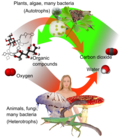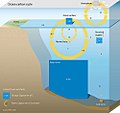Search results
Appearance
The page "Chemical autotrophy" does not exist. You can create a draft and submit it for review or request that a redirect be created, but consider checking the search results below to see whether the topic is already covered.
- {{cite book}}: CS1 maint: others (link) Kellerman, M. Y.; et al. (2012). "Autotrophy as a predominant mode of carbon fixation in anaerobic methane-oxidizing...12 KB (1,202 words) - 13:46, 26 June 2024
- G, Elvert M, Yoshinaga MY, Lin YS, Holler T, et al. (November 2012). "Autotrophy as a predominant mode of carbon fixation in anaerobic methane-oxidizing...19 KB (1,636 words) - 13:31, 17 June 2024
- energy production by oxidation of inorganic substances in association with autotrophy — what would be named today as chemolithoautotrophy. Later, the term would...9 KB (806 words) - 13:36, 19 October 2024
- produce organic materials needed to sustain their own metabolism (i.e. autotrophy). Such biological activities are known as photosynthesis, and examples...7 KB (690 words) - 22:41, 15 October 2024
- Ammonium (category Articles containing unverified chemical infoboxes)nitrification, which produces nitrate and nitrite. This process is a form of autotrophy that is common amongst Nitrosomonas, Nitrobacter, Nitrosolobus, and Nitrosospira...20 KB (2,099 words) - 14:03, 15 September 2024
- originally thought. The majority of fixed carbon is now thought to come from autotrophy, specifically methanogenesis. Direct measurements of methane production...64 KB (6,895 words) - 18:19, 24 September 2024
- Autotroph (redirect from Autotrophy)such as carbon dioxide, generally using energy from light or inorganic chemical reactions. Autotrophs do not need a living source of carbon or energy and...19 KB (2,041 words) - 17:03, 8 November 2024
- of heredity and the possibility of light playing a role in chemical synthesis (autotrophy). Evidence grew to support this theory in 1953, when Stanley...28 KB (2,963 words) - 13:47, 23 August 2024
- been the first microbial food for heterotrophic microorganisms before autotrophy evolved. Sagan and Khare note the presence of tholins through multiple...34 KB (3,568 words) - 19:39, 10 May 2024
- Archaea (section Role in chemical cycling)sunlight as an energy source, and other species of archaea fix carbon (autotrophy), but unlike plants and cyanobacteria, no known species of archaea does...158 KB (16,722 words) - 19:34, 6 November 2024
- and primary producers, with limited production of microbial biomass via autotrophy. The trophic networks in this region rely on particulate organic matter...49 KB (5,362 words) - 13:11, 13 May 2024
- "Nitrosopumilus maritimus genome reveals unique mechanisms for nitrification and autotrophy in globally distributed marine crenarchaea". Proceedings of the National...13 KB (1,334 words) - 02:24, 3 September 2024
- Acidithiobacillus thiooxidans (section Autotrophy)Retrieved 9 November 2013. Hansford, G. S.; T. Vargas (February 2001). "Chemical and electrochemical basis of bioleaching processes". Hydrometallurgy. 59...23 KB (2,365 words) - 21:14, 30 March 2024
- G, Elvert M, Yoshinaga MY, Lin YS, Holler T, et al. (November 2012). "Autotrophy as a predominant mode of carbon fixation in anaerobic methane-oxidizing...31 KB (3,540 words) - 04:52, 14 September 2024
- Hendrik M.; Herndl, Gerhard J. (2010-08-15). "Major contribution of autotrophy to microbial carbon cycling in the deep North Atlantic's interior". Deep...50 KB (6,023 words) - 04:23, 13 November 2024
- as planktonic arrow worms and bristle worms. The distinction between autotrophy and heterotrophy often breaks down in very small organisms. Recent studies...77 KB (7,077 words) - 05:08, 29 October 2024
- Marine snow (category Chemical oceanography)Reinthaler T, van Aken HM, Herndl GJ (August 2010). "Major contribution of autotrophy to microbial carbon cycling in the deep North Atlantic's interior". Deep...22 KB (2,737 words) - 21:03, 24 June 2024
- can also use the histidine, leucine and arginine autotrophy. The advantage of using those autotrophies lies in the fact that they exhibit wild-type or...89 KB (9,974 words) - 11:56, 29 October 2024
- Oceanic carbon cycle (category Chemical oceanography)into organic matter by photosynthesis (equation 5) and other forms of autotrophy that then sinks and is, in part or whole, digested by heterotrophs. Particulate...60 KB (6,469 words) - 16:04, 6 November 2024
- McIntire, C.D., Davis, M.W., Kentula, M.E., Whiting, M. (1983). Benthic Autotrophy in Netarts Bay, Oregon. Report prepared for Environmental Protection Agency...34 KB (4,210 words) - 08:30, 22 August 2024
- hydrothermal vents, methane clathrates, cold seeps, and whale falls. e. Autotrophy Autotrophy (from the Greek autos = self and trophe = nutrition) is the production














